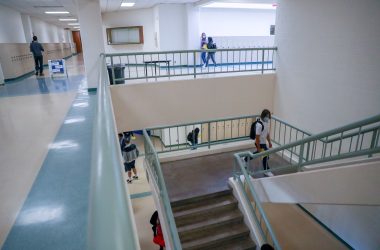
A student works on an assignment at Highland Elementary on Sept. 7, 2018. (Moriah Ratner/Special to the Salem Reporter)
Salem-Keizer students lag behind their peers across Oregon on state tests, results released Thursday morning show.
About half of Salem students meet Oregon standards in English and science, compared to 55 percent and 60 percent, respectively, across the state. One-third meet math standards, compared to state results of 41 percent.
Though there’s significant variation among individual schools and grade levels, Oregon students overall are performing no better on the assessments than they were four years ago when the state began using Smarter Balanced tests for English and math.
Oregon has used the same science test, the Oregon Assessment of Knowledge and Skills, since 2005.
Students are tested on English and math in third, fourth, fifth, eighth and eleventh grades, and on science in fifth, eighth and eleventh grade.
While Salem’s scores generally are lower than Oregon averages, high school juniors in Salem do better than the state average in English and math.
Linda Myers, district director of strategic initiatives, said that shows students who are behind their peers in earlier grades by high school pass them in those two subjects.
“One of the things that we have seen over time is that our middle schools do a good job of accelerating achievement for kids,” she said.
The district added a seventh period to middle school days last year to allow students who are behind to take an extra class focused on getting them up to grade level.
Salem-Keizer officials said that districtwide gains by groups of students signaled progress. For instance, 39 percent of fourth graders met state standards for English and language arts on the test last year, versus 35 percent of third graders the year before.
Myers said a new math curriculum, Ready Math, accounted for score gains at some elementary schools. The curriculum was piloted last year at Highland, Keizer, Morningside, Scott and Salem Heights elementary schools.
State results show mixed gains among students at those schools, however. Highland third-graders scored seven percentage points higher on math tests, but fourth-graders scored 12 percentage points worse.
Only two of the five schools showed gains among all grades. At Scott Elementary, 17 percent of students met math standards versus 13 percent in 2016-17. Morningside went from 53 percent of students passing to 55 percent.
Science is a different story: just 52 percent of all Salem students met state standards, compared with 60 percent of Oregonians.
Lillian Govus, district spokeswoman, said that could be explained in part by the lack of science classrooms across the district, something the recently-passed bond will address.
“Right now at the middle school level we can’t even offer a full year of science because we don’t have enough lab space,” she said.
Superintendent Christy Perry said in a news release the district has room to do better, but cautioned against using one year’s results as a benchmark for student achievement.
“Our students are more than just numbers on an assessment. They are young people who speak more than 60 languages at home and bring a multitude of experiences – some wonderful and some incredibly difficult – with them when they come to school,” she said.
State data shows persistent achievement gaps at all grade levels. While 55 percent of all students met English standards last year, those numbers were significantly lower for students receiving free or reduced lunch (42 percent), Latino students (38 percent), students with disabilities (19 percent) and English language learner students (7 percent).









